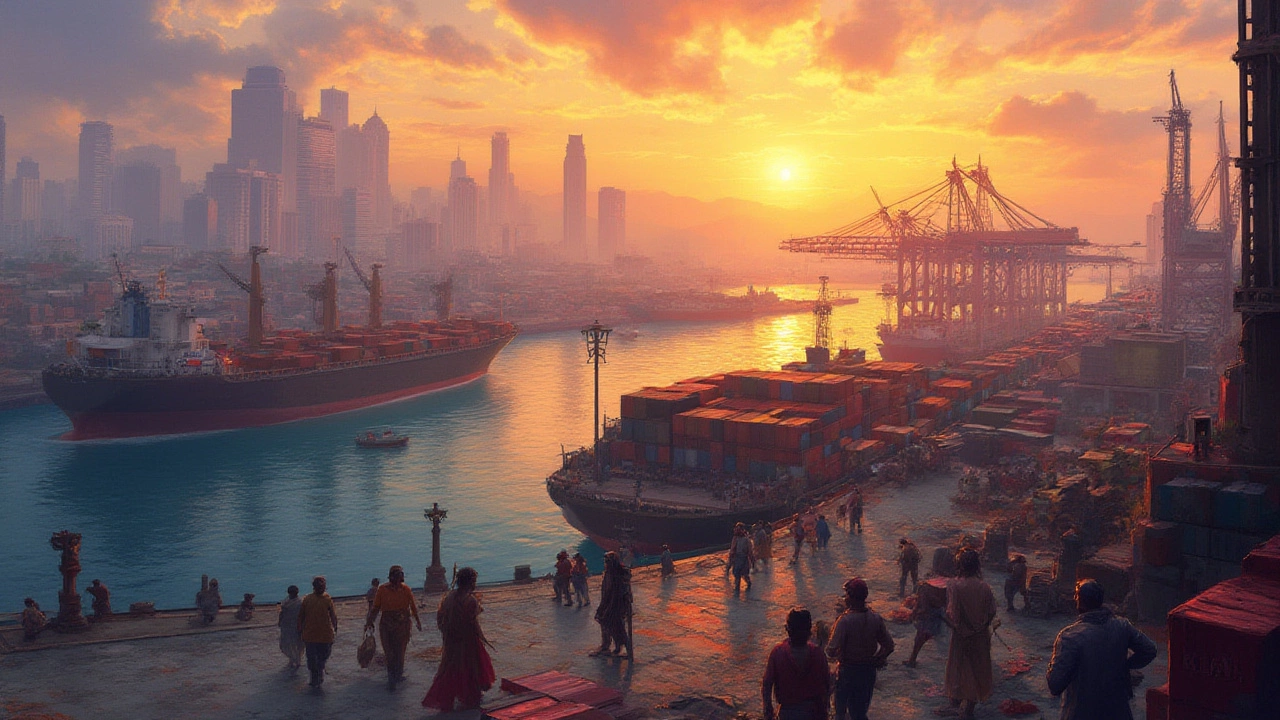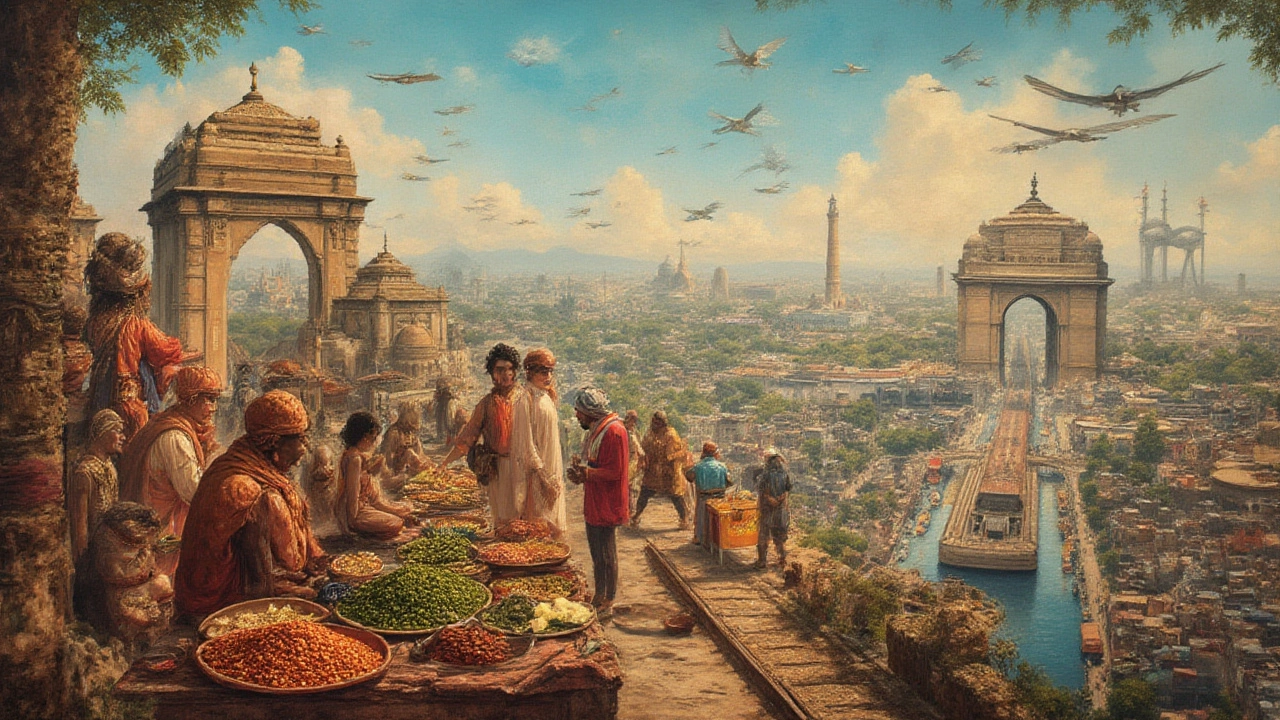
India may feel like a story you’ve heard before: ancient spices, colourful fabrics, and endless caravans. But the wild part is, India’s trade game is just as intriguing now as it was centuries ago. Even today, people across Europe, Asia, and Africa pull open a cupboard and probably see something ‘Made in India.’ So, what is it about this country that makes it click with traders, big and small, generation after generation?
From Ancient Spice Routes to Modern Trade Giants
Take a look back, and you’d see ancient Indian ports bustling with Greek, Roman, and Persian merchants long before globalisation was a thing. India’s location wasn’t just luck—it’s a sweet spot. With coastlines stretching over 7,500 km and access to important sea lanes (like the Arabian Sea and Bay of Bengal), traders couldn’t resist stopping by. Why? It was where you’d get black pepper, cinnamon, muslin, indigo, and precious stones. People say Roman elites wouldn’t sit for dinner without Indian pepper on the table.
This natural advantage shaped India’s identity as an exporter. Overland, the Silk Road wound through, connecting traders from China to Europe through the dotted caravanserais of northern India. Over the seas, the monsoon winds even got their own fan club—sailors figured out they could plan their trips using the seasons, turning what looked like a weather curse into a timetable for commerce. If you check Pliny’s writings from first-century Rome, he complains that India drained Rome’s gold through luxury imports.
The British colonial era changed the scene, sometimes for worse and sometimes for better. India was plugged forcibly into global trade networks—its textiles and raw materials went to Britain, and Indians ended up buying British manufactured goods. Railways, telegraphs, and ports built by the British to ease extraction later became assets to India once it snatched independence. By the late 1940s, India was left with a mixed bag: damaged homegrown industries but a network ready for a reboot.
India’s ancient history isn’t just a fun story; it’s baked into how the country still thinks about trade. There’s a certain comfort—almost tradition—in dealing with new partners. This keeps India flexible, adaptable, and constantly hustling for an edge.
Geography, Infrastructure, and Homegrown Ingenuity
India’s geography is a bit like having all the cheat codes. Plenty of raw materials—think iron ore, cotton, tea, spice, and precious minerals—are within reach. And then there’s the coastline. Ports like Mumbai, Chennai, Kochi, and Kolkata have been upgraded to handle today’s monster container ships since the 1990s. Jawaharlal Nehru Port (JNPT), for example, now makes the top-40 container ports globally. Back in the 1960s, you’d barely call India’s port system efficient, but now you’ll see it moving over 600 million tonnes of cargo annually.
The Indian Railways, the world’s fourth largest rail network by size, connects the hinterland to the docks—so even villages that once felt forgotten are part of the global supply chain. Highways and expressways now weave across every major trading zone, thanks to a chunk of government spending over the last 20 years. India’s “Golden Quadrilateral” highway network, for example, links Mumbai, Delhi, Kolkata, and Chennai, covering nearly 6,000 kilometres.
But what really keeps the wheels spinning is local creativity. Indian entrepreneurs don’t just follow the trend—they tweak, adapt, and resist when needed. Textile hubs in Surat, diamond polishers in Gujarat, and tech parks in Hyderabad show how India adapts to whatever customers demand. Even late at night, small family-run businesses are stitching, coding, or packing for exports. No wonder India ranked as the world’s 6th largest exporter of services and also made it into the world’s top 20 merchandise exporters in 2024.

Economic Reforms and Changing Policies
Few countries have switched gears as dramatically as India did in 1991. Until then, India ran on the “license raj”—bureaucratic rules, red tape, and import controls kept the gates tight. Imports were restricted to protect local industries, but this made them less competitive. The fiscal crisis of the early ’90s forced India to open up. Tariffs dropped, foreign investment came in, and private companies sprinted ahead.
Exports went from just $18 billion in 1991 to over $770 billion by 2024. That’s more than a forty-fold jump. The big story? India’s not just shipping out rice or textiles anymore. IT services, pharmaceuticals, cars, and even smartphones now head out in massive numbers. India’s generic drugs, for instance, supply about 20% of the world’s total exports by volume. The tech scene is no slouch either—companies like Tata Consultancy Services (TCS) and Infosys have contracts with Fortune 500 clients everywhere.
A game-changer was the introduction of Special Economic Zones (SEZs). These pockets offer tax incentives, simplified customs, and fast-track infrastructure. Most big export success stories—mobile handsets, electronics, software—come from SEZs in cities like Noida, Pune, and Hyderabad.
Trade agreements help, too. For example, the India-ASEAN Free Trade Agreement lets Indian products move easily into Southeast Asia, a market of 650 million people. India’s “Act East” policy is about plugging into Asia’s growth, while conversations on trade pacts with the UK, EU, and Australia show the hustle is far from over.
| Year | Exports (USD Billion) | Imports (USD Billion) |
|---|---|---|
| 1991 | 18 | 24 |
| 2010 | 220 | 350 |
| 2024 | 770 | 914 |
People love data, and those numbers tell a story of transformation. If your neighborhood shopkeeper suddenly turned into an Amazon-scale exporter, that’s India from 1991 to today.
Technology, Skill Power, and The Indian Mindset
Most folks don’t realize how much the digital boom changed Indian trade. A simple YouTube ad? It’s probably made by an Indian freelancer for a German startup. IT exports are a lifeline, bringing in around $330 billion according to 2024 estimates—over 10% of GDP. That’s not a typo. The Indian government’s focus on digital payments, GST, and single-window customs (ICEGATE platform) has made exports smoother than ever.
India turns its population size into an asset. Over 500 million people make up its workforce, and the country produces more engineers than the US and Germany combined every year. IT campuses, English language hubs, coding bootcamps, and design studios are churning out a new breed of workers ready for the global grind.
Then there’s the Indian mindset. Call it hustle, jugaad, or resilience—Indians find ways around obstacles. If a market closes a door, they find a window. This is why Indian startups export SaaS products, and cotton farmers organize WhatsApp groups to sync shipping with international buyers. Have you ever used Zoho, Freshworks, or Ola? All are Indian companies with global clients.
Beneath the surface, policies support upskilling. Government certification schemes like Skill India and Make in India have trained millions, and you see it everywhere—small units with ISO standards, villages learning export compliance, and more young people speaking business-friendly English and Mandarin Chinese. India’s focus on skilling up its people gives it a labour advantage others can’t easily copy.
On the business side, tax breaks for exporters, easier access to export finance, and customs modernization mean that exporting goods and services isn’t just possible for conglomerates. Even a family-owned herbal tea brand in Assam or a ceramics workshop in Jaipur can break into Europe, Japan, or the Gulf states.
If you’re thinking of tapping into India’s trade network, start by finding a local partner who understands both the global trends and the uniquely Indian way of negotiating. Trust me, the relationships matter as much as the quality of goods. Don’t ignore the regional festivals and customs—sometimes a timely Diwali greeting can clinch a deal faster than an email pitch.
In the end, what lets India trade is a mix of old-school connections and new-school hustle. It’s the location, yes, but also centuries of know-how, relentless upgrading, clever use of tech, and the unique Indian knack for making things work when others would throw in the towel. If you’re looking for inspiration on building your own business, or just want to see how a giant keeps moving, India’s trading journey is a masterclass worth studying.
Write a comment